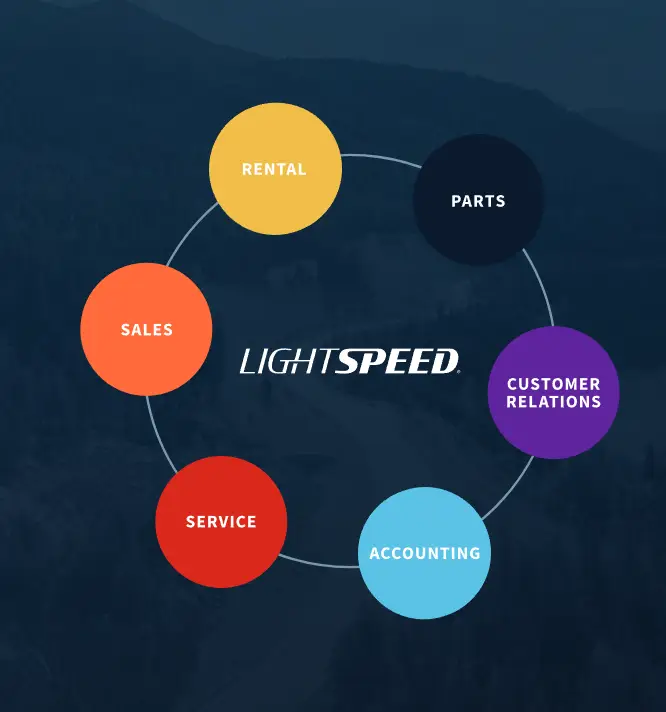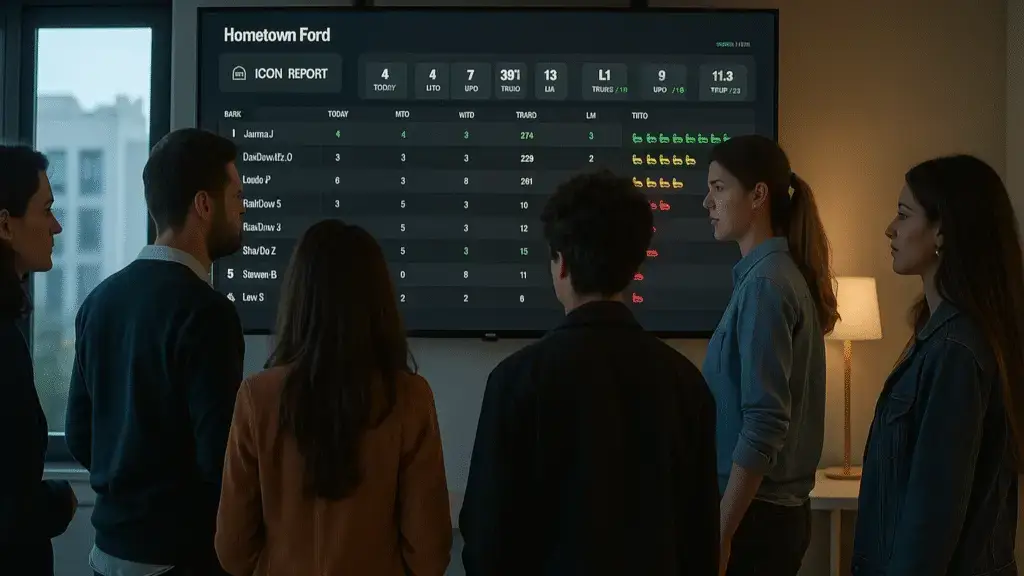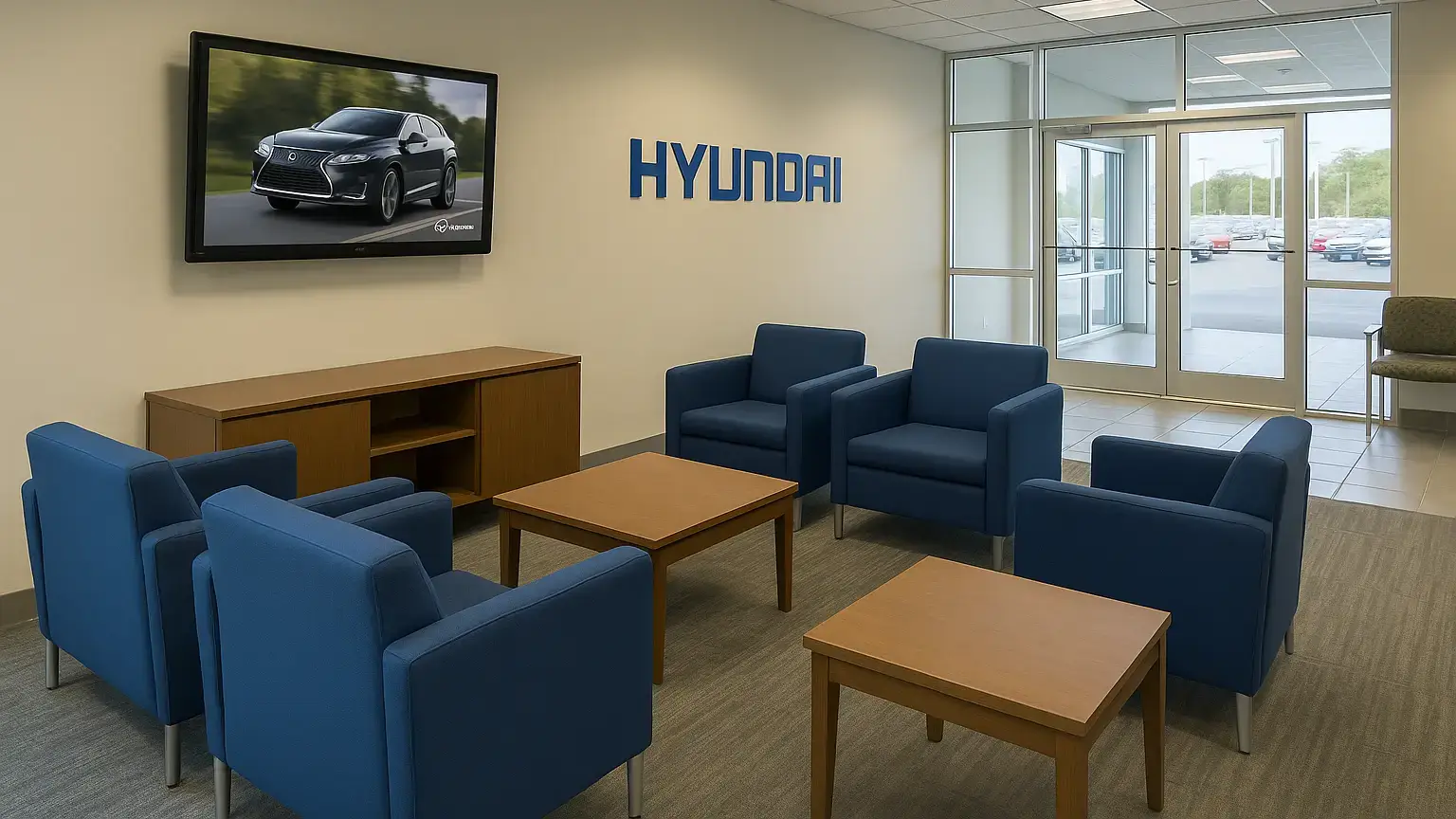Are you trying to make your car dealership stand out? It’s tough with so much competition. But here’s a secret: focusing on digital BDC performance tracking can really help. This means watching how well your team does online, like how fast they answer calls or chats and if they’re making sales.
One cool thing to know is that using digital tools for tracking can give you real-time updates. This lets you make quick decisions to sell more cars. In this guide, we’ll show you steps to track your team’s work easily and boost your sales results.
You’ll learn about the best software and practices to keep an eye on their performance.
Ready for great sales numbers? Keep reading!
Key Takeaways
- Using digital BDC performance tracking can boost car sales by improving online team work. It focuses on metrics like call answer speed and selling success.
- Picking the right tool for your dealership is important. Look for features that match your needs, offer real-time updates, and are easy to use.
- Track key numbers like how fast staff answer calls and how often they close deals. This helps see what’s working or not.
- Training your team on using these tools is crucial. Regular check-ins on progress help adjust strategies for better results.
- Sharing wins keeps teams motivated. Integrating BDC tracking with other tech makes data management smoother and boosts performance.
Understanding Digital BDC Performance Tracking
![]()
Digital BDC performance tracking helps dealerships see how well they are doing online. It shows important numbers and trends that can lead to better sales.
Importance for car dealerships

Digital BDC Performance Tracking is vital for car dealerships. It helps improve customer interactions and drives better results. Tracking performance metrics, like call answering rate and close rate, allows dealerships to see what works.
This data enables smarter decisions that boost sales numbers.
Key Performance Indicators (KPIs) show how well a dealership is doing. They can track lead generation and conversion rates too. With real-time analytics from an advanced BDC Dashboard, teams can optimize their work.
Measuring these key metrics leads to success in the automotive industry.
Benefits of tracking performance metrics
![]()
Tracking performance metrics provides many advantages for dealerships. It helps improve customer interactions and boosts sales results. Dealers can measure important metrics like call answering rate, response time, average talk time, and close rate.
These key performance indicators (KPIs) reveal strengths and weaknesses in the sales process.
Business development centers (BDCs) benefit greatly from this tracking. Setting specific sales goals makes it easier to see progress over time. This data management empowers teams to make smart decisions quickly.
BDC Performance Tracking is critical for maximizing dealership success in the automotive industry. It drives better outcomes by analyzing data effectively and enhancing customer engagement through improved digital marketing strategies.
Implementing Digital BDC Performance Tracking
![]()
Implementing Digital BDC Performance Tracking can boost your sales. Choosing the right tools and following best practices will help you see great results.
Choosing the right solution for your dealership

Choosing the right solution for your dealership is key to tracking BDC performance. The right tools can drive sales results and optimize operations.
- Analyze Your Needs: Assess which features are most important for your dealership. Look for solutions that help with lead generation and conversion into sales.
- Evaluate Key Metrics: Track important data like response time, call answering rates, and close rates. Good software should provide insights into these key performance indicators (KPIs).
- Research Available Solutions: Explore different BDC tracking solutions on the market. Compare features, prices, and user reviews to find the best fit.
- Look for Real-Time Analytics: An advanced BDC dashboard gives you real-time information about performance. This allows quick decision-making to address issues as they arise.
- Consider Integration Capabilities: Check if the solution works well with your current systems. Seamless integration helps in managing data effectively across platforms.
- Seek User-Friendly Features: Choose a tool that is easy for your team to use. If staff can navigate it easily, they will use it more often.
- Ask About Support Services: A strong support system is vital when using new technology. Ensure that help is available when you need it, whether through chat or phone support.
- Set Clear Goals: Before implementing any solution, define specific goals for your BDC team. Setting targets increases focus on maximizing dealership performance.
- Review Success Stories: Learn from other dealerships that have seen improved sales results using BDC tracking solutions. Their experiences can guide your choices.
- Test Before Committing: Many software providers offer demos or trials of their products. Use this opportunity to see how well the solution meets your needs before making a purchase.
Each point helps you select the right digital BDC performance tracking solution to drive better sales at your dealership.
Best practices for optimizing performance
Optimizing performance is key for car dealerships. It can lead to better sales results and higher customer satisfaction.
- Track Key Performance Indicators (KPIs). Measure call answering rates and response times. These metrics show how well your team interacts with customers.
- Use an advanced BDC Dashboard. This tool offers real-time analytics. It helps you make smart decisions quickly.
- Set specific sales goals. Clear targets help your team focus on increasing sales. Goals should be challenging yet achievable.
- Monitor average talk time and close rate. These metrics reveal how effectively your team communicates and sells to customers.
- Analyze data regularly. Frequent reviews of performance metrics allow you to spot trends and adjust strategies quickly.
- Integrate tracking solutions with other technologies in the dealership. This connection streamlines data management for BDC performance.
- Train your sales team continuously. Regular training keeps skills sharp and improves interactions with prospects.
- Encourage teamwork among staff members. Collaboration enhances motivation and leads to higher success rates for everyone involved.
- Celebrate small wins along the way. Recognizing progress keeps the sales team motivated and engaged in their work.
- Stay informed on automotive industry strategies and trends through articles or seminars that cover various aspects of BDCs, from best practices to new technologies available for optimizing dealership performance.
Success Stories and Results with Digital BDC Performance Tracking
![]()
Many dealerships saw big sales boosts after using digital BDC performance tracking. These stories show how tracking helps teams stay motivated and achieve more.
Real-life examples of improved sales results
Digital BDC Performance Tracking has helped many dealerships boost their sales. For example, a dealership that used an advanced BDC Dashboard saw a 30% increase in leads within three months.
They focused on key metrics like call answering rate and response time. This change motivated their sales team and improved customer interactions.
Another case showed a dealership that set clear sales goals. They tracked data closely with KPI monitoring for dealers. With these steps, they raised their close rate by 25%. These real-life examples show how effective digital tracking can be in driving results for automotive dealerships.
How digital tracking can motivate and retain sales teams
Digital BDC Performance Tracking can greatly motivate sales teams. It provides clear data on key performance indicators, like call answering rates and close rates. Salespeople see their progress in real time.
This helps them stay focused on their goals. Setting specific sales targets also drives motivation and accountability.
Tracking results improves team morale too. Team members can celebrate wins together when they see improvements in average talk times or response times. Such recognition keeps the team engaged and eager to perform better every day.
With effective dashboard analytics for BDC, everyone knows what to aim for, making success a shared goal across the dealership.
How to Get Started with Digital BDC Performance Tracking
![]()
Start by assessing your dealership’s needs. Choose a tracking solution that fits those needs well.
Step-by-step guide
Digital BDC Performance Tracking is key for sales success. Follow these steps to get started.
- Define Your Goals: Set clear sales goals for your Business Development Center (BDC). Specific goals help track progress and boost motivation.
- Choose a Tracking Solution: Select the right BDC tracking solution for your dealership. Look for tools that provide real-time analytics and reports.
- Identify Key Metrics: Focus on important Key Performance Indicators (KPIs). Track call answering rate, response time, average talk time, and close rate.
- Train Your Team: Educate your staff on using the digital BDC tools. Proper training helps everyone understand how to improve performance.
- Monitor Performance Regularly: Use the advanced BDC Dashboard to check data often. Regular monitoring allows you to make smart decisions based on current numbers.
- Analyze Sales Results: Review the data regularly to measure success. Look at how well leads convert into sales, so you can find areas needing improvement.
- Integrate with Other Technologies: Connect your BDC system with other dealership technologies. This creates a comprehensive view of customer interactions and sales results.
- Address Common Challenges: Be prepared to face challenges in implementation. Have a plan to solve issues related to team buy-in or technology use.
- Adjust Strategies as Needed: Use data analysis to adapt strategies over time. Flexibility will help you make changes that drive better results for your dealership.
- Celebrate Successes: Share successes within your team as you see improvements in tracking dealership success. Acknowledging achievements motivates everyone on the sales team.
Implementing these steps will enhance your ability to drive sales results effectively through digital BDC Performance Tracking.
Integration with other dealership technologies
Integrating Digital BDC Performance Tracking with other dealership technologies can greatly improve sales results. This connection allows for better data sharing. For example, integrating with your CRM system helps track leads more effectively.
Key Performance Indicators (KPIs) become clearer when systems work together.
Using an advanced BDC Dashboard gives real-time analytics on each department’s performance. Important metrics like call answering rate and close rate are easily monitored. These insights empower dealerships to make smart decisions based on actual data.
Improved communication between different technologies also motivates and retains sales teams, driving better results in online advertising and eCommerce tracking.
Common challenges and solutions
Tracking digital BDC performance has its challenges. Knowing these challenges helps dealerships find solutions.
- Data Overload: Dealing with too much data can confuse staff. Use an advanced BDC Dashboard to simplify data management. This dashboard provides real-time analytics. It helps teams make smart decisions.
- Lack of Training: Staff may not know how to use new tools properly. Offer training sessions on BDC tracking solutions. Teach your team about key performance indicators and metrics they need to track.
- Inconsistent Metrics: Different teams may track different metrics. This inconsistency leads to confusion and errors in analyzing sales results. Set clear guidelines about which key metrics to monitor for better alignment across departments.
- Resistance to Change: Employees might be hesitant to adopt new technology or methods. Communicate the benefits of digital BDC performance tracking clearly. Show how it can improve sales results and help them succeed.
- Integration Issues: Connecting BDC tracking solutions with existing dealership technologies can be difficult. Work with a tech partner who understands automotive analytics best practices for smooth integration.
- Limited Feedback Loops: Without regular feedback, it’s hard for teams to improve their performance continuously. Implement a system for frequent reviews of call answering rates, response times, and close rates so that the sales team knows where they stand.
- Tracking Accountability: It might be hard to hold team members accountable for their performance metrics without clear expectations in place. Set specific sales goals tied directly to individual responsibilities within the digital BDC framework.
- Monitoring Team Morale: High-pressure environments can hurt morale over time, especially when tracking progress closely becomes too intense. Create a positive culture by celebrating small wins and improvements in team performance regularly.
- Adapting Metrics Over Time: Market trends change quickly, making some metrics less relevant over time while others become more important for success at dealerships. Continually reassess what key metrics you are using in your performance tracking and adapt as needed.
- Ignoring Customer Feedback: Not considering customer insights may lead to missed opportunities or mistakes in strategy adjustments from BDC interactions. Use customer feedback as a critical component of analyzing your dealership’s sales results instead of viewing it as secondary information.
Each challenge carries its own set of solutions that drive success when implemented effectively through consistent monitoring of digital BDC performance metrics.
Conclusion

Digital BDC Performance Tracking is key for car dealerships. It helps improve customer interactions and boosts sales. Simple steps can make this process easy to implement. Focus on key metrics like call rates and response times.
How will you track your team’s success? Using these tools can lead to better results and stronger sales teams. Explore more resources to enhance your skills in BDC tracking. Take charge now, and watch your dealership thrive!
FAQs
1. What is BDC performance tracking?
BDC performance tracking involves monitoring the digital Business Development Center (BDC) to assess its effectiveness using key metrics and Key Performance Indicators (KPIs).
2. Why should I implement BDC tracking solutions?
Implementing BDC tracking solutions helps you monitor your business’s digital performance, allowing you to make data-driven decisions that can drive sales results.
3. How does The Ultimate Guide to Digital BDC Performance Tracking help my business?
The guide provides detailed information on how to effectively track your digital BDC’s performance, including the key metrics for assessing success and driving better sales outcomes.
4. What are some of the key metrics for BDC tracking?
Key metrics for BDC tracking often include KPIs related to sales results such as lead conversion rates, customer engagement levels, and overall revenue growth.




